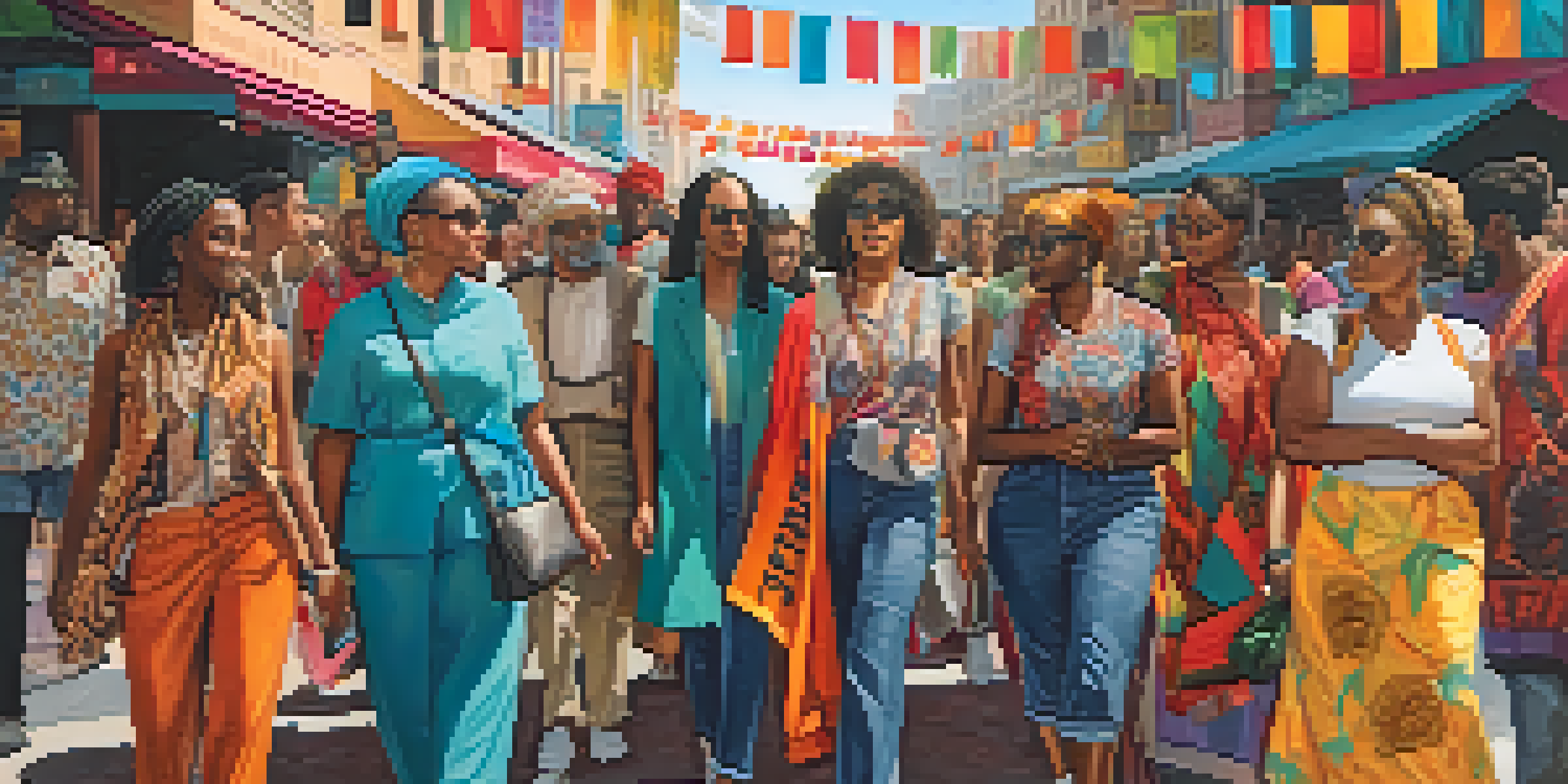Fashion Activism: Merging Style with Social Justice

Understanding Fashion Activism and Its Impact
Fashion activism is a movement that uses clothing and style to promote social change. It emphasizes the power of fashion as a form of expression and a medium for addressing critical social issues. By blending style with advocacy, fashion activists challenge norms and inspire conversations around topics like sustainability, equality, and human rights.
Fashion is the armor to survive the reality of everyday life.
This approach to activism encourages individuals to think critically about their fashion choices and the messages they send. For example, wearing a shirt that supports a cause can spark dialogues and raise awareness. This makes every outfit an opportunity to express values and inspire action.
Ultimately, fashion activism is about more than just looking good; it's about making a statement and encouraging others to join the cause. It reminds us that our everyday choices can contribute to larger movements, making fashion a powerful tool for change.
The Role of Sustainable Fashion in Activism
Sustainable fashion plays a vital role in fashion activism by promoting environmentally friendly practices. This includes using ethically sourced materials, reducing waste, and supporting fair labor practices. By prioritizing sustainability, fashion activists address not only social justice but also the urgent environmental challenges we face today.

Brands like Patagonia and Reformation are excellent examples of how sustainability can intersect with activism. They advocate for environmental protection while encouraging consumers to make conscious choices. With campaigns that highlight the impact of fast fashion, these brands inspire a shift toward more sustainable practices.
Fashion as a Tool for Change
Fashion activism uses clothing to promote social justice and spark important conversations around critical issues.
By choosing sustainable fashion, activists not only support ethical practices but also encourage others to reconsider their consumption habits. This fosters a community of mindful consumers who prioritize the planet over fleeting trends, making a significant impact in the fight for environmental justice.
Celebrities as Fashion Activists
Celebrities often have a tremendous influence on public opinion, making them powerful allies in fashion activism. Many stars use their platforms to raise awareness about social and environmental issues, encouraging fans to join the cause. From wearing statement pieces to launching their own sustainable lines, celebrities can spark conversations and inspire change.
In a world where you can be anything, be kind.
For instance, Emma Watson has long championed sustainable fashion, using her red carpet appearances to promote eco-friendly designers. Similarly, Rihanna's Fenty brand emphasizes inclusivity and diversity, sending a strong message about representation in the fashion industry. These actions not only elevate their brands but also highlight the importance of activism in fashion.
By leveraging their visibility, celebrities can amplify the voices of activists and inspire their audiences to take action. Their involvement can lead to broader conversations around social justice, making it clear that fashion is not just about aesthetics but also about values and integrity.
Grassroots Movements in Fashion Activism
Grassroots movements are at the heart of fashion activism, often driven by communities that are directly affected by social issues. These movements emphasize local engagement and empower individuals to take action in their own communities. Through workshops, events, and social media campaigns, grassroots activists spread awareness and drive change.
An example is the Fashion Revolution movement, which began after the Rana Plaza disaster in Bangladesh. This initiative encourages consumers to ask, 'Who made my clothes?' and promotes transparency in the fashion supply chain. By shining a light on exploitation and unsafe working conditions, grassroots movements like this push for systemic change in the industry.
Sustainable Choices Matter
Prioritizing sustainable fashion encourages ethical practices and fosters a community focused on environmental responsibility.
These local efforts highlight the importance of community involvement in creating a more just and equitable fashion landscape. As more people join these movements, the collective voice grows stronger, fostering a culture of accountability and responsibility within the fashion world.
The Intersection of Fashion and Identity
Fashion is intrinsically linked to identity, allowing individuals to express who they are and what they believe in. Fashion activism recognizes this connection and encourages people to embrace their unique identities while advocating for social justice. This intersection creates a powerful platform for marginalized voices to be heard.
By promoting diverse representation in fashion, activists challenge stereotypes and encourage inclusivity. This can be seen in campaigns that celebrate body positivity, gender fluidity, and cultural diversity. When individuals see themselves represented in the fashion world, it fosters a sense of belonging and empowerment.
Ultimately, embracing our identities through fashion allows us to challenge societal norms and advocate for change. By wearing our beliefs, we not only express ourselves but also inspire others to share their stories and stand up for what they believe in.
Consumer Responsibility and Ethical Choices
As consumers, we hold immense power in shaping the fashion industry. Our purchasing decisions can either support harmful practices or promote ethical ones. Fashion activism encourages us to take responsibility for our choices and consider the impact of our spending habits on people and the planet.
Making ethical choices involves seeking out brands that prioritize sustainability, fair labor practices, and transparency. This may mean investing in quality pieces that last longer or supporting local artisans and businesses. Every conscious decision contributes to a larger movement for change and signals to brands that consumers care about social justice.
Empowerment Through Identity
Fashion activism allows individuals to express their identities while advocating for inclusivity and social change.
By becoming informed consumers, we can help drive the industry toward more ethical practices. Fashion activism teaches us that our choices matter and that we can be part of the solution by supporting brands that align with our values.
The Future of Fashion Activism
The future of fashion activism looks promising as more individuals and brands embrace the movement. With growing awareness around social and environmental issues, we can expect to see innovative approaches that merge creativity with advocacy. This evolution will likely lead to more collaborations between activists, designers, and consumers.
As technology continues to advance, we may also see new platforms for activism emerge. Social media has already proven to be a powerful tool for raising awareness, and it will likely play an even more significant role in mobilizing communities. This connectivity allows activists to share their stories, making the movement more inclusive and impactful.

Ultimately, the future of fashion activism hinges on our collective commitment to change. By continuing to advocate for social justice through fashion, we can create a more equitable and sustainable industry that reflects our values and inspires future generations.